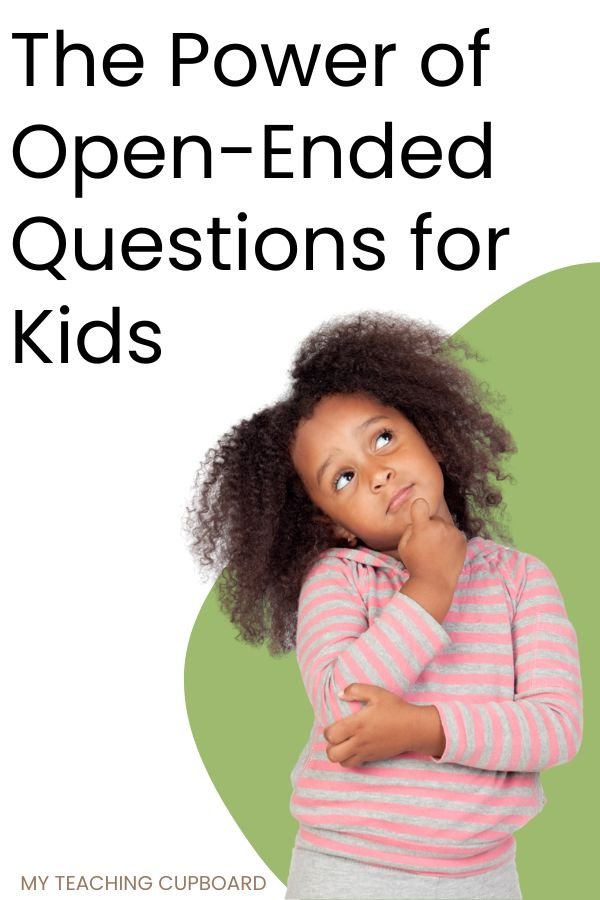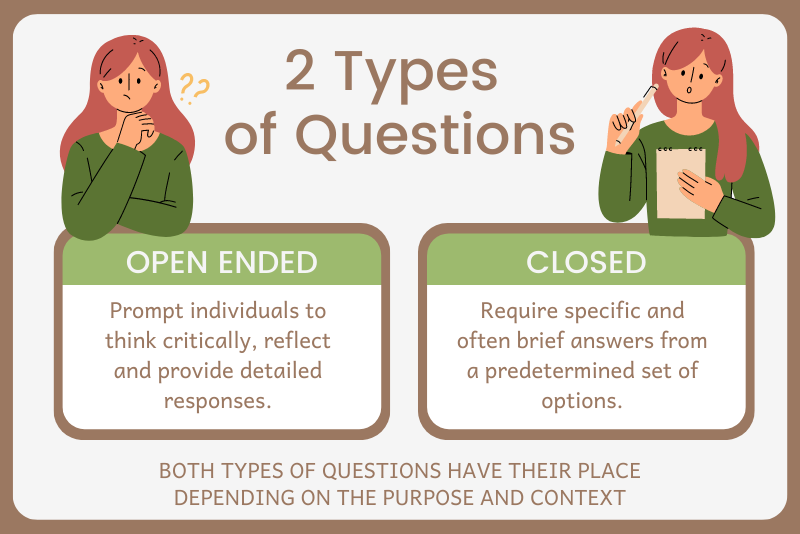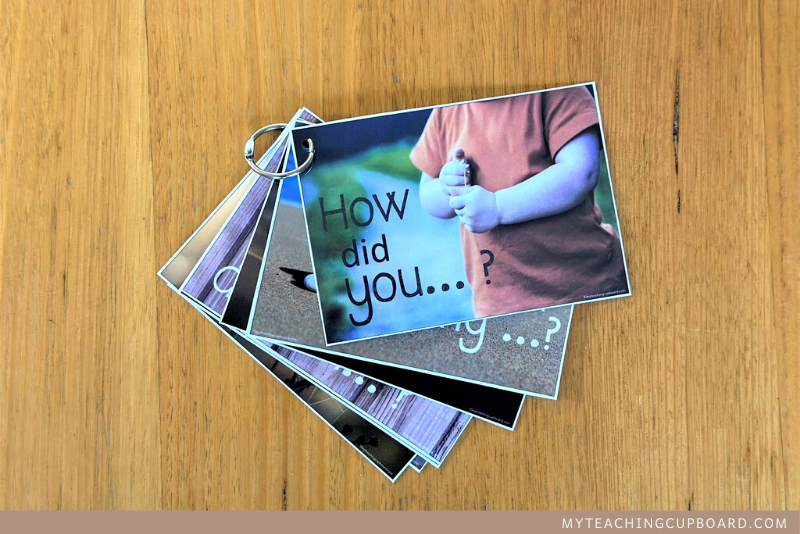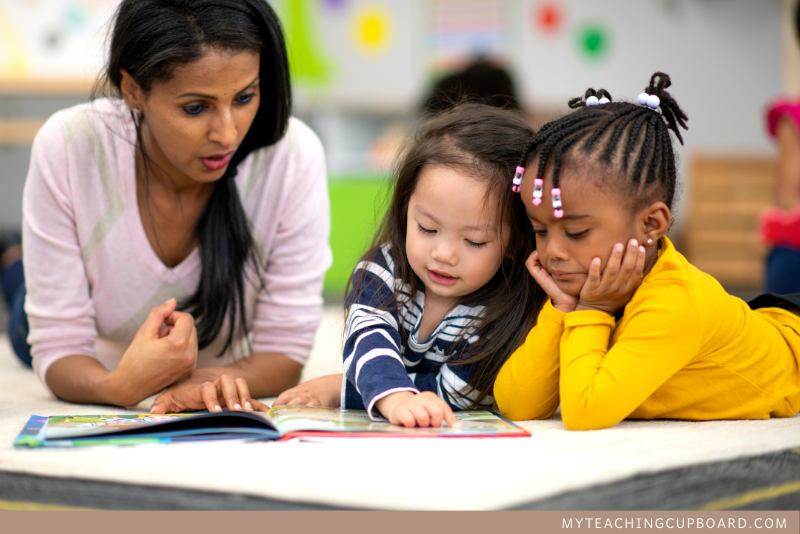The Power of Open-Ended Questions for Kids
Open-ended questions for kids are a great way to promote exploration and discovery in young learners. Find out how to use them in your classroom and get examples, tips, and resources.
Asking open-ended questions is a great way to spark creativity and curiosity in kids. These types of questions encourage children to think deeply and to share their thoughts.
In this blog post, we'll explore the numerous benefits of using open-ended questions with kids. You will also discover some open ended question examples to get you started using them in your classroom.
The best thing about using open-ended questions in the classroom is the ability they have to empower little kids to share what they are thinking. Open-ended questions have the potential to unlock the true depth of a child's thinking, imagination, and potential.
Here are some ways in which open-ended questions can empower your little ones:
Encourage Critical Thinking: Open-ended questions prompt children to think critically, analyse situations, and consider all possible perspectives. By challenging children to reflect, evaluate, and generate their own ideas, open-ended questions can encourage independent thinking and decision-making skills. Critical thinking helps children learn to question assumptions, evaluate information, and form their own opinions, and that’s going to help them develop autonomy and self-confidence.
Foster Creativity and Imagination: When children are asked open-ended questions, their imaginations are sparked. They are encouraged to think creatively. This empowers them to explore new possibilities, express their unique ideas, and develop a sense of originality and innovation.
Build Confidence and Self-expression: Open-ended questions provide children with the opportunity to express themselves freely and without judgment. It’s all about how you respond. By listening attentively and valuing a child’s response, you can create a safe space where children feel confident in sharing their thoughts, ideas, and opinions.
When you ask your kids open ended questions and really listen to their responses, you will be demonstrating that you value their thoughts and ideas. This goes a long way in building their self-confidence and helps them feel more comfortable in sharing their opinions with others.
Promote Communication and Language Skills: Open-ended questions encourage children to engage in meaningful conversations and articulate their thoughts effectively. By actively listening to their peers' responses and engaging in discussions, children will develop important communication skills like active listening, turn-taking, empathy, and the opportunity to express their ideas.
Nurture Problem-Solving Abilities: Open-ended questions stimulate children's problem-solving skills by challenging them to explore different solutions and think outside the box. They learn to analyse situations, consider various options, and develop their problem-solving skills.
These are very important skills. Problem solving skills are not only beneficial in academic settings like the classroom but it is predicted that they will be necessary in children’s future professional lives.
Problem solving skills are crucial in navigating real-life challenges and adapting to an ever-changing world.
Develop a Love for Learning: When children are asked open-ended questions, they become active participants in their learning journey. Their curiosity is piqued, and they develop a genuine love for learning. Open-ended questions create a sense of ownership and engagement, making learning more meaningful and engaging for children.
Ultimately, open-ended questions hold the power to unlock a child’s full potential. By fostering critical thinking, creativity, self-expression, and problem-solving skills. These types of questions can empower children to become confident, independent learners who are equipped with the tools they need to navigate the world with curiosity, resilience, and a thirst for knowledge.
Why Open-Ended Questions Matter in Early Childhood Education
Open-ended questions play a critical role in developing higher-order thinking skills in young children. When we ask children to explain their reasoning or consider new possibilities, we’re actually guiding them through the upper levels of Bloom’s Taxonomy — analysing, evaluating, and creating.
In the Early Years Learning Framework (EYLF), children are encouraged to become confident and involved learners who can think critically, problem-solve, and communicate effectively. Open-ended questioning supports these outcomes by:
Encouraging children to explore multiple solutions.
Strengthening their ability to make connections between ideas.
Developing persistence and resilience in tackling challenges.
This should not and does not stop when children enter primary school. In the Australian Curriculum (ACARA), particularly across the early years of Mathematics, Science, and Literacy, children are expected to engage in reasoning, explanation, and justification. Using open-ended questions during play or explicit teaching helps them meet these benchmarks in a developmentally appropriate way.
👉 Want to see this in action? Check out my post: Using Open-Ended Questions to Promote Higher Order Thinking.
What Is an Open Ended Question?
Open-ended questions and closed-ended questions are two different types of questioning styles. They will give you very different types of responses. Let’s take a closer look at open ended and close ended questions.
What Are Open-Ended Questions?
Open-ended questions for kids are questions that can’t be answered with a simple “yes” or “no.” They invite children to share their thinking, explain their reasoning, and explore possibilities.
Instead of one right answer, open-ended questions allow for many different ideas and perspectives.
💡 Examples of open-ended questions:
Why do you think the block tower fell over?
How could we solve this problem differently?
What might happen if we mix these two colours together?
What do you notice about this pattern?
What else could we use to measure this?
Open-ended questions are designed to encourage a more thoughtful and detailed response. They cannot be answered with a simple yes or no. There's no right or wrong answer.
These types of questions do not have a specific answer and require the child to provide their own ideas, opinions, or explanations. Open-ended questions typically start with words like why, how, or what if.
If you are looking for a one-word answer, don't use these types of questions.
More Examples of Open-Ended Questions
Why do you think it is going to rain today?
How would you solve this problem?
What will happen if you add red paint to that mixture?
Open-ended questions are an excellent way to promote critical thinking, reflection, and the exploration of different perspectives. They spark discussions in the classroom and encourage your students to think creatively and express their thoughts and ideas.
Closed-Ended Questions
Closed-ended questions, on the other hand, are designed to elicit a specific, brief, and direct response. Very often, the response can be judged as either being correct or incorrect.
Closed-ended questions are questions with a short, fixed answer . Often “yes” or “no,” or a single piece of information. They’re great for checking facts, recalling knowledge, or assessing specific skills, but they don’t encourage children to expand on their ideas.
💡 Quick examples of closed-ended questions:
Did you read your book?
How many counters do you have?
Which pencils are longer than yours?
Are you going to work in the blocks area today?
Closed questions typically have quite a limited set of predetermined answers. They can be seen as simple questions because they often require a simple yes or no response.
✅ When to use them:
Closed-ended questions are useful for:
Gathering quick or precise information.
Checking for understanding.
Formal assessments.
⚠️ When not to rely on them:
They’re less effective for promoting creativity, problem-solving, or higher-order thinking because the answer choices are so limited.
There is a place for these types of questions in the classroom. I’m not suggesting they should be avoided. Closed-ended questions are useful for gathering specific information and obtaining precise data.
If you are after one or two word answers, these are the types of questions you will be asking.
More Examples of Closed-Ended Questions
Did you read your book?
How many counters do you have?
Which pencils are longer than yours?
Are you going to work in the blocks area today?
Close-ended questions are useful in situations where you need specific information quickly or when conducting assessments requiring standardised responses. They are not as effective as open-ended questions when it comes to promoting critical thinking and encouraging detailed responses.
Unlike open-ended questions that allow for deeper exploration and thoughtful answers, closed-ended questions limit the response options and often only require short or specific answers. This means that closed-ended questions don't provide as much opportunity for children to think critically or elaborate on their thoughts and ideas.
Unlike a closed question, an open-ended question gives you the opportunity to really investigate your student's thinking. You will gain valuable information about your children and their developmental level when you use open ended questions in your classroom.
Open-Ended Questions in Different Areas of Learning
One of the best things about open-ended questions is how flexible they are. You can use them across every single learning area to spark curiosity, deeper thinking, and rich discussions. Here’s how they can look in different parts of the curriculum:
Open-Ended Questions in Maths
Maths should not be just about right or wrong answers. For deeper mathematical understanding, maths should be about reasoning and problem-solving. When you ask “How did you work that out?” or “What else could we try?”, you give your children space to explain their thinking and explore multiple strategies.
👉 Learn more in these blog posts:
Open-Ended Questions in Preschool Learning
Preschoolers are naturally curious so open-ended questions are the perfect way to nurture their wonder. Asking things like “What might happen if we pour the water here?” or “What do you think the caterpillar is doing?” invites children to make predictions and share their ideas.
👉 I’ve shared a list of my favourites in this blog post: The Best Open-Ended Questions for Preschool Kids
Open-Ended Questions in Investigations and Play
During investigation time, open-ended questions are a powerful scaffold. Try asking a thoughtful open ended question like “What do you notice?” or “How could you make that better?” Extend your student’s learning and challenge their thinking.
👉 See how I use them in this blog post: Using Open-Ended Questions to Promote Higher Order Thinking
Open-Ended Questions in Literacy
Asking “Why do you think the character made that choice?” or “What might happen next in the story?” transforms literacy time into an exercise in prediction, comprehension, and empathy.
Open-Ended Questions in Science
Simple prompts like “What do you think will happen if we mix these two liquids?” or “Why do you think shadows change during the day?” encourage children to hypothesise, observe, and explain.
Whether you’re teaching maths, literacy, science, or investigations, open-ended questions are a bridge to higher-order thinking, creativity, and curiosity.
10 Open-Ended Questions to Get Kids Thinking
Open-ended questions are a great way to help children develop their problem-solving skills. Check out this list of open-ended questions that will not only get your students thinking but also be the start of some great conversations!
What do you think would happen if...?
How would you solve this problem?
What do you notice about...?
Can you tell me more about...?
What do you think about...?
How do you feel about...?
What would you do differently next time?
What questions do you have about...?
What do you think might happen next?
How could we make this better?
If you would like to use open questions like these in your classroom, you will love my 30 Open ended Question Prompts on Nature Photos
My open-ended question prompts can help you promote problem-solving, creative thinking, and critical thinking skills in your students. They have been designed to foster higher-order thinking and will work with any curriculum and age group.
One of the biggest challenges I faced when I started my play based learning journey was knowing how to interact with the children during investigation time. Should I interrupt them? Should I just observe? What do I say?
I knew you were supposed to scaffold their learning, but I struggled sometimes in doing that. That's where these question prompts came in.
They were one of the most important things I introduced. I found the best way to use them was to print them out in a task card size and carry them around with me. They were the perfect starting point and helped me to ask the right questions.
This resource contains a lot of questions. 30 captivating open-ended question prompts. Each prompt is designed to be printed on A4 paper or card. If you prefer a smaller size, instructions are included to tile the printing to fit 2 or 4 images on a page.
Place these cards around your classroom and use them in your play based learning areas to prompt your questioning. They are a great discussion springboard and will challenge your students to think deeply and invite them to share their unique perspectives.
I love the nature theme and the beautiful images used in these prompts. They really will enhance any learning environment.
Teacher Tips for Asking Open-Ended Questions
Here are five tips to keep in mind when asking this type of question in the classroom:
Create a Safe and Supportive Environment: You will only reap the benefits of open-ended questions in a classroom where the children feel safe and valued. It is so important to create a positive and welcoming classroom environment where your children feel comfortable expressing their thoughts and ideas.
You really need to encourage a non-judgmental atmosphere that values all responses and promotes a sense of inclusivity.
Your tone of voice and body language are crucial elements in effective questioning, so use a warm and inviting tone of voice that conveys genuine curiosity and enthusiasm.
Maintain an open posture, face the child directly, and lean in slightly to show them you are genuinely interested in what they have to say. Smile, nod, and provide positive reinforcement to create a supportive and encouraging classroom environment where children feel valued.
Use Open and Inviting Language: Frame your questions using open-ended language that encourages children to think deeply and share their own ideas. Remember, open-ended questions start with words like why, how, or what if. Avoid closed-ended questions that can be answered with a simple yes or no. Open ended questions are good conversation starters.
Practice Active Listening: You can demonstrate active listening by maintaining eye contact, nodding, and showing genuine interest in your children's responses.
Both verbal and non-verbal cues are important too. Children are exceptionally good at reading your body language, so make sure your body and your words say you value their thoughts.
Try saying, Tell me more, as you lean in attentively.
Incorporate Visual Prompts: Use visual aids like my, 30 Open ended Question Prompts on Nature Photos to support open-ended questions and stimulate children's thinking.
By displaying one or two printed prompts in a play-based learning invitation, you will be provoking your students to think deeply, problem-solve, and express their thoughts. Printed prompts can also guide and encourage your children to engage in more meaningful conversations and explore the learning resources in different ways. Prompts are one of the best tools for developing critical thinking skills and expanding the learning experience.
Encourage Elaboration and Reflection: After a child shares their initial response with you, try prompting them to elaborate on their answer. You can do this by asking follow-up questions that delve deeper into their thinking. Ask your child questions like "How do you know that?" or "That's so interesting. Can you tell me more?"
Encourage your students to reflect on their experiences. Ask them how they feel, and what they think could happen next, to explain their thinking further or give you the reasons behind their responses.
A Checklist to Help You Ask Open-Ended Questions Effectively
Asking open-ended questions is an art and with a little practice, it can become a natural part of your teaching style. Here’s a simple 5-step checklist you can download and use to make your questions more powerful:
1. Create a Safe and Supportive Environment - Children will only answer openly if they feel their ideas are valued. Smile, make eye contact, and keep your tone warm and inviting. Avoid jumping in with corrections and instead, listen first and respond with curiosity.
✅ Tip: Try phrases like “That’s an interesting idea!” or “Tell me more…” to show you value their thinking.
2. Use Open and Inviting Language - Frame your questions with words like why, how, what if, or tell me about…. These prompts encourage children to elaborate instead of stopping at “yes” or “no.”
✅ Example: Instead of “Did the tower fall?” ask, “Why do you think the tower fell?”
3. Practice Active Listening - Demonstrate that you are truly listening by leaning in, nodding, and repeating back parts of what children say. This models respectful conversation and encourages them to expand.
✅ Tip: Use follow-ups like, “That’s so interesting, can you explain more?” or “How do you know that?”
4. Incorporate Visual Prompts and Props - Sometimes children need a concrete starting point. Displaying question cards, story props, or photos can help spark their curiosity.
✅ Try placing one of my 30 Open-Ended Question Prompts on Nature Photos in a play area — it can guide conversations and challenge children’s thinking without you having to hover.
5. Encourage Elaboration and Reflection - Don’t stop at the first answer. Encourage children to add detail, make connections, and reflect on their thinking.
✅ Ask: “What could happen next?” “What would you do differently next time?” or “How do you feel about that?”
DOWNLOAD YOUR PRINTABLE CHECKLIST HERE and follow this 5-step guide. Soon you’ll find open-ended questions becoming second nature in your classroom. They not only make discussions richer but also give you valuable insight into your children’s thinking and development.
By implementing these strategies, you will be well on your way to asking effective open-ended questions that promote critical thinking, communication, and active participation among your students.
6 Benefits of Open-Ended Questions for Kids
Open-ended questions not only get children talking, but they also shape the way kids think, learn, and interact with the world.
Why are open-ended questions so important in the classroom?
Here are six powerful benefits you’ll notice in your classroom when you make open-ended questioning part of your daily practice:
Encourage Critical Thinking
When children are asked “Why do you think that happened?” instead of “Oh – Did you see what happened?” they begin analysing situations, questioning assumptions, and weighing up possibilities.
💬 In my classroom, I once asked, “Why do you think the paint is dripping down the paper?” and a child piped up, “Because gravity is pulling it!” Another child quickly added, “No, because the brush had too much water!” That one question led to a whole mini science lesson.
2. Foster Creativity and Imagination
Open-ended questions unlock imagination because there’s no single “right” answer.
💬 During block play, I asked, “What could this tower be?” One child saw a rocket, another a castle, and a third said it was a tall tree. The same pile of blocks became three completely different stories and they were all sparked by a single question.
3. Build Confidence and Self-Expression
Children feel valued when their answers aren’t judged as right or wrong. They learn that their thoughts matter.
💬 When I asked, “What’s your favourite part of today’s story?” a quiet child who rarely spoke and very rarely raised her hand actually put up her hand and softly shared her thoughts. The other kids listened closely, and you could see her beam with pride at being heard.
4. Promote Communication Skills
Open-ended questions naturally stretch children’s language and encourage richer conversations.
💬 In one small group, I asked, “What do you notice about these shells?” The children began describing colours, patterns, and textures, bouncing ideas off each other. It turned into a back-and-forth conversation rather than a one-word response.
5. Nurture Problem-Solving Abilities
By asking children how they might approach a challenge, you help them practise flexible thinking and resilience.
💬 In construction play, a block tower kept falling so I asked, “What could you try differently?” Instead of giving up, the children tried adding a wider base and celebrated when it finally stood tall.
6. Develop a Love for Learning
When kids are invited to share their ideas, they feel ownership of the learning process. That’s when curiosity and engagement skyrocket.
💬 After a science provocation, I asked, “What questions do you still have about magnets?” The children’s responses ranged from “Can magnets stick to water?” to “What if the Earth is a magnet?” Their wonder carried us into days of follow-up investigations.
That’s the real power of open-ended questions!! They spark real thinking and encourage creativity, curiosity, and higher-order thinking in kids. By asking open-ended questions, teachers can help their students develop their problem-solving and communication skills, as well as their ability to think deeply and critically.
And on top of that, open-ended questions allow for a wider range of answers, which can lead to more meaningful discussions and a deeper understanding of the curriculum topics. Overall, using open-ended questions in the classroom can help foster a love of learning and a lifelong curiosity in young children too.
Why wouldn’t you want to be using them?
Troubleshooting: 5 Common Mistakes Teachers Make (and How to Fix Them)
Even the best of us slip into habits that limit the power of open-ended questions. If you’ve tried them before and felt like they “didn’t work,” it might be one of these common pitfalls. Each one has a simple fix!
1. Asking Too Many Closed Questions - It’s easy to default to a quick yes/no question like “Did you finish your work?” or “Is that your answer?” — especially when you’re short on time.
✅ Fix: Be intentional. For every closed question, follow up with one open-ended question such as “How did you get that answer?”
2. Not Giving Children Enough Wait Time - Young children often need a few extra seconds to think and respond. Jumping in too quickly can shut down their ideas.
✅ Fix: Count to five silently after asking. That pause can be all it takes for children to process and respond thoughtfully.
3. Rushing to “Correct” Answers - We sometimes feel pressure to guide children to the “right” response, but this can cut short their creativity and confidence.
✅ Fix: Value the process over the product. Respond with “That’s an interesting idea, tell me more” before offering guidance.
4. Not Listening Actively - If we’re half-distracted, children pick up on it. They may even stop sharing or give shorter answers.
✅ Fix: Show genuine interest through body language, nodding, and repeating back what you heard. It tells children their ideas matter.
5. Using Questions Too Complex for the Child’s Stage - A question that’s too abstract can confuse children and lead to silence. For example, “Why do you think friendship is important?” may be tricky for a 4-year-old.
✅ Fix: Match questions to developmental levels. Instead, ask “What makes someone a good friend?” to invite more concrete responses.
Remember it’s about being intentional. With a few small shifts, I know that your open-ended questions will start unlocking richer, more meaningful conversations in your classroom.
Resources & Next Steps
If you’re excited to bring more open-ended questions into your classroom, here are some helpful resources to guide you further:
Related Blog Posts
Each of these explores the different areas of learning and gives you practical examples you can try straight away.
Resources to Save You Time
👉 Don’t forget to grab my ready-to-go printables. All perfect for printing and using in your learning areas. They’ll make open-ended questioning and higher-order thinking a seamless part of your teaching:
30 Open-Ended Question Prompts on Nature Photos → Printable question prompts to spark conversations and encourage higher-order thinking.
Higher-Order Thinking Prompts → Printable questions for deep classroom conversations.
STEAM Challenge Cards → Low-prep open-ended building and problem-solving prompts.
Open-Ended Math Problems (Kindergarten & Year 1 sets) → Hands-on maths challenges with multiple solutions, perfect for rotations or investigations.
Each of these resources gives you a shortcut to meaningful, curriculum-aligned questioning so you can spend less time planning and more time engaging with your students.
The takeaway? Open-ended questions are simple, powerful, and transformative. Start small, use the resources above, and you’ll soon see the difference in your children’s thinking, confidence, and love of learning.
The True Power of Open Ended Questions
In conclusion, the power of using open-ended questions in early childhood classrooms and with younger kids cannot be overstated. By using open-ended questions in your classroom, you will unlock a world of possibilities for your young learners. From fostering critical thinking and creativity to promoting communication and language skills to developing problem-solving abilities. Open-ended questions are the bomb!
Use open-ended questions to empower your children to become active participants in their own learning journey.
A Takeaway Idea: As an early childhood educator, one key takeaway is to consistently incorporate open-ended questions into your daily teaching practices.
Start small by selecting a few open-ended questions related to a particular lesson or topic, and gradually increase their usage over time.
Encourage your younger children to think critically, express their ideas, and explore multiple perspectives through open-ended questions.
Remember, the goal is to create an inclusive and stimulating learning environment where children feel empowered to share their thoughts and engage in meaningful conversations.
The best part about embracing the power of open-ended questions is that early childhood educators like us can ignite that passion for learning we are always looking for in our play-based classrooms.
Did you ever think a question had the power to nurture creativity and equip young kids with essential skills for their future?
Every question holds the potential to unlock a child's imagination, spark curiosity, and inspire a lifelong love for learning. Embrace the power of open-ended questions for kids today!!









